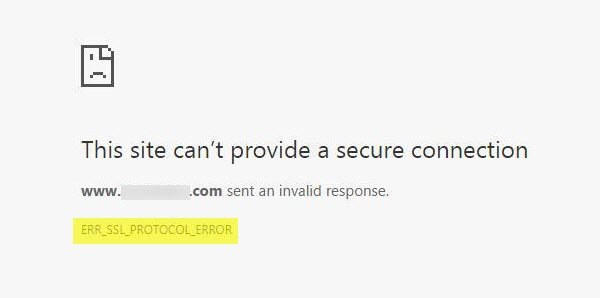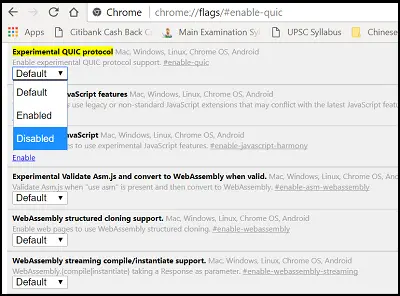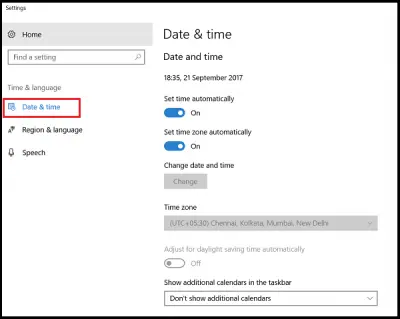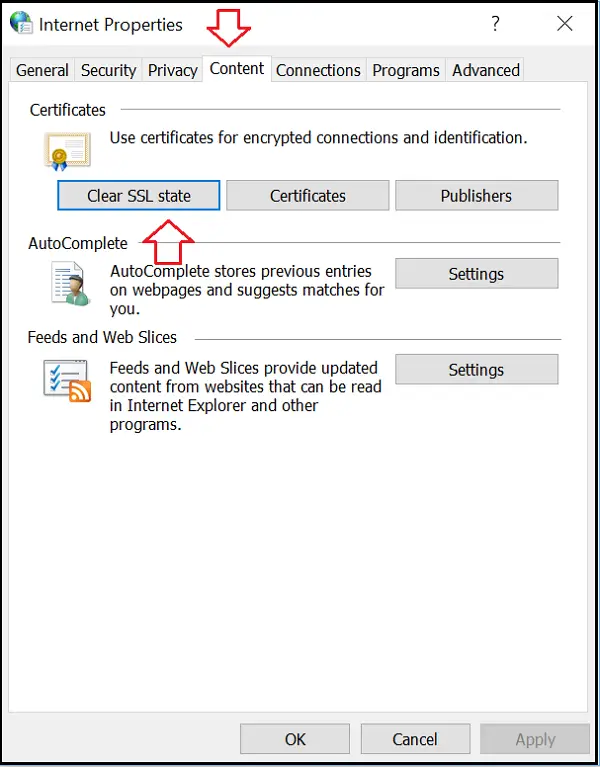Google Chrome is the preferred choice for many Internet users to browse the web. It is fast and secure but sometimes is known to cause problems. For example, when you try to connect to a website, you may receive an error message – This site can’t provide a secure connection and displays the following error code ERR_SSL_PROTOCOL_ERROR. On most occasions, this error is due to a problem with the server, or it may require a client authentication certificate that might not be available. Also, the same error could be caused by several other reasons. Nevertheless, here are a few solutions that you can try to fix the nagging issue.

Fix ERR_SSL_PROTOCOL_ERROR Chrome error
To enable users to browse safely on Chrome, Chrome requires websites to use trustworthy certificates. A secure website must have trustworthy SSL (Secure Sockets Layer) certificates. In other words, if the website doesn’t have a trustworthy SSL certification on Chrome, you may face this error.
See the URL of the website. If the connection is secure, the address should begin with HTTPS (note the s at the end). Alternatively, you can check the security status on Chrome’s address bar. How? To the left of the website address, check the security status. The website is secure if ‘Secure’ with a lock icon appears on your computer screen. Besides ‘Secure’, if you notice ‘Info or not secure’ or ‘Not secure or dangerous, you should abandon the website immediately.
To fix ERR_SSL_PROTOCOL_ERROR on Chrome in Windows 10, you have to:
- Disable Chrome QUIC Protocol
- Configure Correct Date and Time Settings
- Disable your Internet Browser Extensions
- Clear your SSL state
- Change Your Internet Security And Privacy Level
- Exclude SSL protocol scanning in your Antivirus settings.
If you are sure that the website is genuine, proceed to troubleshoot as follows:
1] Disable Chrome QUIC Protocol
Disabling of QUIC Protocol method in Chrome is one of the tried and tested methods to fix SSL errors. So if you want to disable the QUIC protocol on the Google Chrome browser, copy the following address and paste it into the address bar.
chrome://flags/#enable-quic
and hit Enter.

Next, select “Disabled” in the drop-down list and restart your Google Chrome browser. Hereafter, it would help if you stopped seeing SSL_PROTOCOL_ERROR in Google Chrome.
2] Configure Correct Date and Time Settings
Sometimes, a change in date and time settings can cause this conflict. So, it is better to configure this setting appropriately.
First, type Date and Time settings in the search box and choose this setting. Next, click on “change Date & Time” to change it.
Click on “Time Zone” to change the same.

When done, press OK.
3] Disable your Internet Browser Extensions
When you face an SSL connection error, try launching Google Chrome in Incognito mode and loading the same web page with an SSL connection error. If you can access the webpage, you can be sure that one of your extensions is giving this error. Try to find out the culprit extension and then disable it or remove the extension. To do so, open the Google Chrome browser, click on the Menu icon at the top right and select the ‘More Tools’ option.
Next, click on the Extensions options and uncheck the Enabled option marked against the extension you want to disable.
Then, click on Remove to delete it completely.
4] Clear your SSL state
Sometimes the SSL state can unknowingly block the SSL connection. Proceed with these steps to clear your SSL state:
Open Control Panel and click Network and Internet applet in the Category section.

Then, select Network and Sharing Center and choose Internet Options.
Finally, click Clear SSL state in the Content tab and press the OK button.
5] Change Your Internet Security And Privacy Level
If you have set the “High” level as your security and privacy level, it might block some unknown connections, including SSL connections. That may result in an Err_SSL_Protocol_Error error flashing on your computer screen.
By changing these settings to “Medium” or “Low”, you can fix this issue, and your SSL connections will no longer be blocked. To change your internet security and privacy level, open Control Panel and choose Internet Options.
Next, select the “Security” tab and set the “Medium” level.

Do the same with the “Privacy” tab. After changing these settings, try reloading your Google Chrome browser to confirm if the issue is resolved or persists.
5] Exclude SSL protocol scanning in your Antivirus settings
Sometimes, an Antivirus application can cause unknown problems. So, to fix this, simply go to Setup > Advance setting > Protocol filtering” >“SSL” > ‘Do not scan SSL protocol’. Why do you need to do this? Because, at times, conflicts between antivirus and encrypted data are inevitable. If this method helps you troubleshoot the problem, then update your browser, antivirus, and operating system. Also, clear your browser data and try to enable your SSL scanner again.
Let us know if anything here helped you.
What is an SSL error in Google Chrome?
If an SSL certificate is not installed on the website you try to access when using Chrome, Google Chrome will display a warning message. It is meant to make users aware that if they use any sensitive data on the website, it may not be safe, and it could be pretending to be another website.
Where is the certificate option in Chrome?
The option is available under Privacy and Security. It helps when you need to import a certificate of a website you are testing or already know and need to access. This optional is mostly used for testing a website. A general consumer should not import unless asked by a trusted person.
Leave a Reply